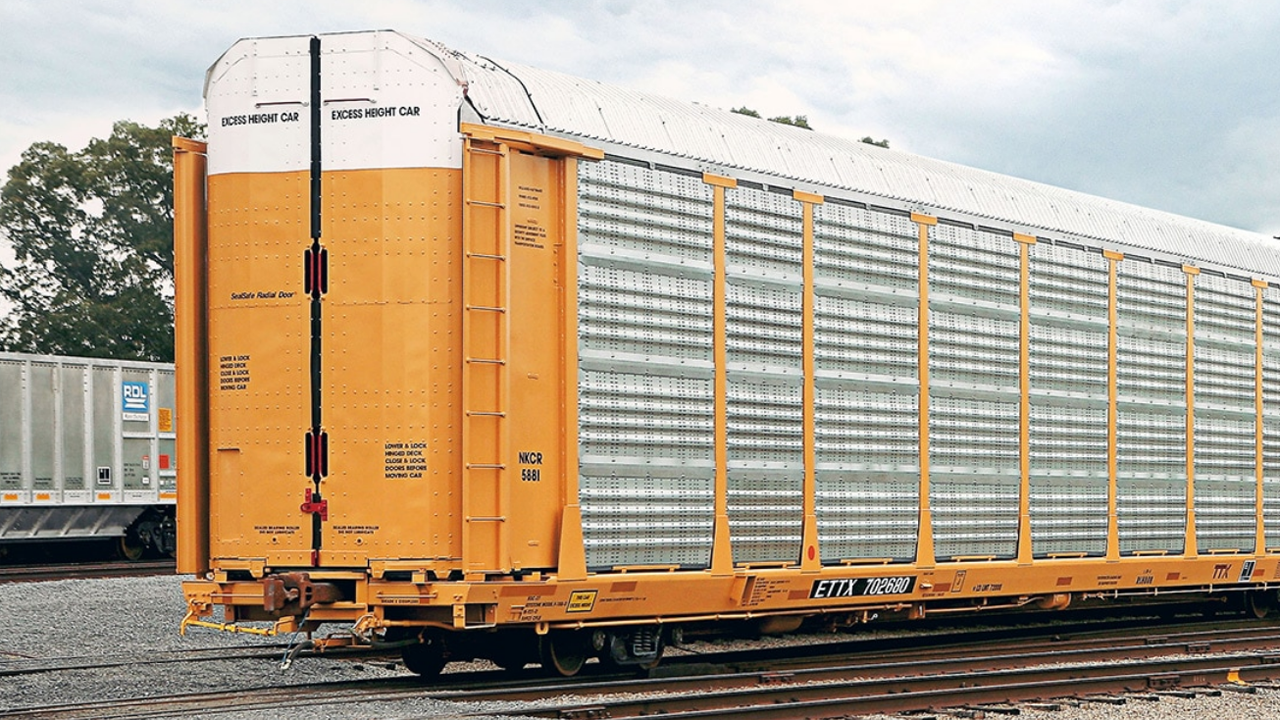
TD Cowen: 3Q23 Surveys Say …
Written by Jason Seidl, Matt Elkott, Bhairav Manawat, Elliot Alper and Uday Khanapurkar , TD Cowen
(Autorack Photograph Courtesy of Trinity)
Railcar demand showed some resilience against a tough macro backdrop, although we view the results of our third-quarter 2023 Rail Equipment Survey as a slight incremental negative for manufacturing and possibly a slight positive for leasing. Our third-quarter 2023 Rail Survey showed that expected rate increases were +3.2%, declining sequentially and sitting below the survey’s long-term average. Business growth expectations remain unchanged, and economic confidence worsened.
3Q23 RAIL EQUIPMENT SURVEY
All Major Order Activity Metrics Deteriorated in 3Q23: When it comes to order activity, we consider four key metrics:
- The percentage of “all participating shippers” who will or may order railcars.
- The conviction level about ordering (the split between “yes” and “maybe”) within this “all participating shippers” group.
- The percentage of “same shippers” who will or may order railcars.
- The conviction level about ordering (the split between “yes” and “maybe”) within this “same shippers” group.

In our 3Q23 survey, the first, second, and fourth metrics deteriorated, while the third improved. The slight deterioration overall in order outlook and conviction could be more a function of extended manufacturing lead times than the underlying need for equipment. One potential risk to manufacturers is if lead times do not shorten quickly enough to take advantage of the current supply tightness, because if rail traffic remains weak and service continues to improve, the supply tightness could be eventually alleviated by further weakening in demand, not higher railcar production.
Decreased Level of Certainty Among Shippers: Roughly 42% of all shippers surveyed said they will or may order railcars in the next 12 months, down from 45% in our 2Q23 survey. Within the 42% of total shippers who are contemplating orders in the next 12 months, 60% said “yes,” they plan to place orders
vs. 70% in 2Q23; and 40% said “maybe” compared with 30% in 2Q23. This could mean a decreased level of certainty about ordering within the total shipper group.
On a same-shipper basis, about 44% of same respondents in 3Q23 said they will or may order railcars, compared to 40% in our 2Q23 survey. Roughly 56% do not plan to order railcars, decreasing from 60% for 2Q23 survey. Within the 44% of same shippers who are contemplating orders in the next 12 months, 60% said “yes,” they plan to place orders (69% in 2Q23), while 40% said “maybe” (31% in 2Q23). This could mean a slightly decreased level of certainty about ordering within the same-shipper group.
3Q23 RAIL SURVEY

Pricing Expectations Declined Sequentially: Shippers anticipate rail prices will increase by 3.2% over the next six to 12 months, 30bps below last quarter’s survey. The 3.2% came in below the survey’s long-term average of 3.6%. The sequentially declining rate expectations are a negative for the rail group,
particularly given the inflationary pressures across the rail network. As we heard on our recent railroad happy hour, market outlook was bleak, with growing uncertainty in 2025; intermodal markets remained challenged (driven primarily by weak OTR rates) and IMCs have muted peak season expectations.
Business Growth Outlook Remained Unchanged and Below Average for Third Quarter in a Row: Business growth expectations stayed flat sequentially at 1.7%, better than our trucking carrier survey outlook but still notably below the survey’s long-term average of 3.7%. Economic confidence fell materially this quarter, down 17% compared to our 2Q23 survey (similar results were seen in our carrier survey), and 5% less as rail shippers stated business levels were positive. Thirty-six percent of shippers expect their employee count to increase over the next 12 months (up 2% sequentially), while 11% expect their employee count to decrease (up 4% sequentially).
Reciprocal Switching Eligibility May Be Wider Than Originally Believed: Following the Surface Transportation Board’s new proposal for reciprocal switching rules based on customer-level service metrics, we asked shippers what proportion of their shipments with Class I’s are picked up within original OETA, i.e. trip plan compliance (the STB’s rule recommends eligibility if TPC<60%). On average, shippers in our survey enjoyed a 54% TPC, though we witness a wide range of metrics with approximately 51% of participants noting a TPC<60%.
While we had previously written that TPC at a system-wide level was relatively robust at each U.S. Class I, results indicate that metrics have a high variance and more shippers could be eligible than initially believed. We will continue to monitor rule-making, which is in early stages (71% of shippers are unclear at this point about whether they will ultimately be able to avail switching remedy).
Thoughts Into Rail Earnings: Worsening pricing expectations, below trend business growth outlook, and declining economic confidence keep us cautious on the railroads as we approach earnings. While the third quarter is understood to be a very challenging environment and commentary from our recent railroad happy hour pointed to a relatively muted peak season despite easy year-over-year comparisons, survey results imply a worsening outlook. Rails normally roll out peak season surcharges, but we have not seen much of that behavior this year because of the light volume environment.
Rail volumes continue to track below 2019 levels. Intermodal volumes are down 8.4% year-to-date,
though we note they have picked up in recent weeks. Over-the-road rates that continue to putter around trough levels have put material pressure on intermodal rates this year. With a notable rebound in OTR rates now likely a back-half 2024 story, we expect intermodal rates to continue to feel pressure into the fourth quarter, though acknowledging favorable comps.



